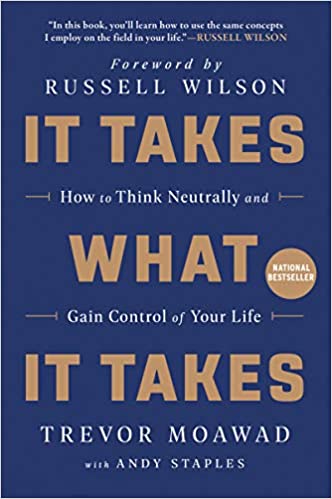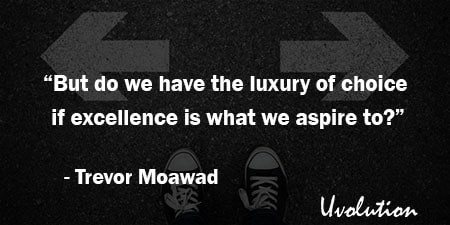It Takes What It Takes by Trevor Moawad Summary
The Book in 1 Sentences
It Takes What It Takes: How to Think Neutrally and Gain Control of Your Life
“That’s why I wrote this book. You don’t need to be an elite athlete to train your mind like one. You simply need to have challenges that must be overcome. And guess what? You’re human.
So you absolutely face challenges every day at work and in your personal life. Maybe you were passed over for a promotion. Maybe you’re trying to go to school to better yourself while working and aren’t sure how to squeeze everything into the twenty-four hours in a day.
Maybe you have a [bad] boss and don’t know how to manage your interactions. Maybe you’ve
just had a child and you’re struggling to adapt to all the extra work at home. Maybe your spouse just told you it’s over.
Once you’ve finished this book, you’ll be equipped with the same tools I’d give a team seeking a title. You’ll learn that champions don’t think negatively or positively; they think neutrally.
You’ll learn that champions behave as if they have no choice. You’ll learn that champions make detailed plans. You’ll learn that champions visualize what they want. You’ll learn
that champions lead themselves before they lead others. You can do this.
By cracking this book open, you’ve already shown you want to grow and change. So let’s do it. It takes discipline. It takes sacrifice. It takes time. It takes what it takes.” ~ Trevor Moawad
6 BIG Ideas
It Takes What It Takes Book Summary
1. It Takes Neutral Thinking
“Down 19-7, Russell [Wilson] hadn’t gone into the tank. You could tell when the Seahawks next got the ball back. ‘We can still win this game!’ Russell yelled. ‘Let’s go! Four minutes and fifty seconds!’
Why hadn’t Russell given up? Why did he treat the next play as if the previous ones didn’t
matter? Because he stayed neutral.
Neutral thinking is a high-performance strategy that emphasizes judgment-free thinking,
especially in crises and pressure situations.
It is the cornerstone of what I teach the athletes and teams that employ me. The thing about neutral thinking that resonates with so many elite athletes, most of whom are deeply skeptical of any self-help, is that it’s real. It’s true.
It acknowledges that the past is irrevocable, that it can’t be changed with mantras or platitudes.
Neutral thinking shuns all attempts at illusion or outright self-delusion, which are often the
foundation of other motivational systems. Neutral thinking strips away the bull and the biases, both external and internal.”
“That’s neutral. Staying in the moment, giving each moment its own history, and reacting to events as they unfold. It takes away emotion and replaces it with behaviors.
Tip #1: What do I do?
Instead of asking, ‘How do I feel?’ you should be asking yourself, ‘What do I do?’”
You can develop these skills if you’re willing to let go of a few things. Negative, cynical thinking
doesn’t make you more realistic. It just makes you negative and cynical.
Biased thinking doesn’t help you either. You need to steer clear of your feelings and make an honest assessment of each situation you face. Don’t worry about what you feel. Rely on what you know.”
“It’s what you do, not how you feel, that gets things done. We can do our way into feeling the way we need to. It’s hard to feel our way into achieving a damn thing.”
Tip #2: Give every bit of yourself!
“A few years into our time working together, I showed Fred [Taylor] a quote that really resonated with him. It was from Norman Vincent Peale.
Peale wrote The Power of Positive Thinking, but he could think neutrally with the best of them:
‘Give every bit of yourself. Hold nothing back. Life cannot deny itself to the person who gives life his all.’”
2. It Takes a Plan
“Three years later, Russell and I would go over this play and its aftermath with former Oklahoma State quarterback Mason Rudolph for our ESPN show QB2QB. ‘Right here, in this moment, you realize that if you’re going to go for something, you’re going to have some heartbreak,’ Russell told Rudolph as the interception played out on a nearby wall.
‘But if you’re not willing to go there, you’re never going to get there.’ In other words, you have to be willing to be the goat—the old, negative meaning of the word my generation grew up with—if you ever want a chance to be the G.O.A.T (what younger generations call the greatest of all time).”
"to be able to hit the game-winning home run, you have to be willing to strike out in the same batter’s box. That translates to football pretty easily. To have a chance to throw the touchdown pass that wins the Super Bowl, you have to be willing to throw the interception that loses the Super Bowl. Those two things live in the same moment.”
Joseph Campbell - In Pathways to Bliss - says: “The hero journey is one of the universal patterns through which that radiance shows brightly. What I think is that a good life is one hero journey after another.
Over and over again, you are called to the realm of adventure, you are called to new
horizons. Each time, there is the same problem: do I dare? And then if you do dare, the dangers are there, and the help also, and the fulfillment or the fiasco. There’s always the possibility of a fiasco. But there’s also the possibility of bliss.”
3. The law of substitution
“Russell understood a critical fundamental: the law of substitution. At any given moment our
minds can sustain only one thought at a time. One. The thousands of words flying through our brains or screams from outside crowds at riot levels can’t overcome that truth. It’s universal.
My mind doesn’t block things out. It simply goes to whatever thought I ask it to go to. My inner voice is loudest. If I don’t use it strategically, however, then the words of others or the outside chaos can replace my message to myself.
My own words influence me ten times as much as anyone else’s. Russell uses that power. We all can.”
“But think about the things you can stop doing right now—today. Think about putting a muzzle on negative expression for the next twenty-four hours. Negative thoughts can cross your
mind. They will. But for one full day forbid yourself from verbalizing them.
Witness the difference that makes in your relationships, your mental state, your outcomes. You’ll be amazed.”
4. The illusion of choice
“My dad was always trying to adjust his phrasing to make it resonate with the largest audience, and he knew when he’d found words that hit the target. This phrasing hit the mark. I could see it in the players’ eyes. I could see it in the coaches’ eyes. They understood.
I see that same recognition every time I present to a new group and explain the illusion of choice. ‘Of all the things you teach, Trev, nothing hit me between the eyes like the illusion of choice,’ MGM Studios COO Chris Brearton told me.
‘It so clearly is true, and yet we all compete against our own choices every day.’ Deep down, we all know our choices ultimately determine our behaviors and those behaviors ultimately determine our outcomes. That doesn’t make choosing correctly any easier in our own lives.”
“Making bad choices is the lifeblood of average. It feeds it. It consumes it. It protects it. Choice is a competitor—as much as any tangible opponent you or any team will face. In fact, it’s the ultimate competitor. It taunts you. It will lie to you. Take choice out of your way, and it’s like pulling the fitness band off Usain Bolt.
The Velcro snaps, and watch his ass disappear. Choice is an illusion. Choice is Keyser Freaking Söze.
This may sound crazy, especially in an age where many people are bombarded by options. The
music we listen to. The shows we watch. The time we wake up. The food we eat. The people we associate with. The way we prepare. The effort we give. The effort we don’t give. But do we have the luxury of choice if excellence is what we aspire to?”
5. It Takes What It Takes!
“I’ve had the honor of working alongside US Navy SEAL Marcus Luttrell over the years. He told his story in Lone Survivor, and it’s a testament to staying neutral.
In June 2005, Marcus and three other members of SEAL Team Ten were dispatched into the Hindu Kush mountains in eastern Afghanistan with a mission to either kill or capture a Taliban leader.
After a group of goat herders stumbled upon the SEALs and gave their location to Taliban soldiers, the Taliban
attacked.
Luttrell’s three teammates were killed and he was left to try to survive an enemy onslaught in an unfamiliar area. Luttrell was shot eleven times. He broke his back and his pelvis and blew out his knees. He broke his nose and bit off a piece of his tongue.
He needed to travel seven miles to reach the nearest village to have any chance of survival.
But he didn’t think about the total distance he had to cover. That would have overwhelmed him and made him quit. As he lay on the ground looking at the moon, he decided to crawl.
He grabbed a rock and drew a line in the dirt. Then he crawled forward. When his feet passed the line, he drew another line. He did that for seven miles. That is the ultimate in neutral thinking.
Marcus didn’t think positively. He didn’t think negatively. He thought, ‘I am capable of crawling to this line.’
The next time life presents you with a challenge, don’t simply assume everything will work
out. Don’t tell yourself you can’t do it. Just evaluate the situation. Figure out what you can
accomplish right now. Then draw your line. When you cross that line, draw another one. And
keep going.”
Joe De Sena - In Spartan Up! - also says: “The way to get through anything mentally painful is to take it a little at a time. The mind can’t handle dealing with a massive iceberg of pain in front of it, but it can deal with short nuggets that will come to an end.
So instead of thinking, Ugh, I’ve got twenty-four miles to go, focus on making it to the next
telephone pole in the distance. Whether you’re running twenty or one hundred and twenty
miles at a time, the distance has to be tackled mentally and physically one mile at a time. The
ability to compartmentalize pain into these small bite sizes is key.”
6. It takes...
1. It Takes Neutral Thinking
2. It Takes a Plan
3. It Takes Hard Choices
4. It Takes a Verbal Governor
5. It Takes a Negativity Diet
6. It Takes an Ad Campaign in Your Brain
7. It Takes Visualizing
8. It Takes Self-Awareness
9. It Takes Pressure
10. It Takes Leadership
11. It Takes Role Models
12. It Takes What It Takes
That was my QUICK summary of the great book It Takes What It Takes by Trevor Moawad. If you’re interested, get your copy. There is a HUGE amount of life-changing ideas in this book, and we’ve only touched on a tiny bit of it.
Buy The Book: It Takes What It Takes by Trevor Moawad

GET Blinkist 7 Days FREE Trial
3000+ Book Summaries
(Audio and Text)








